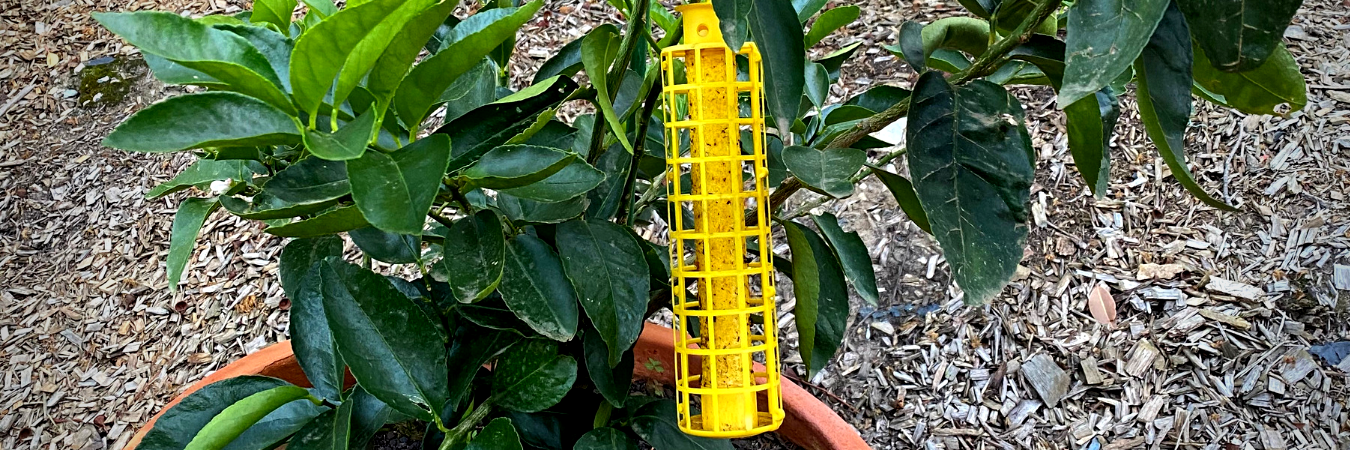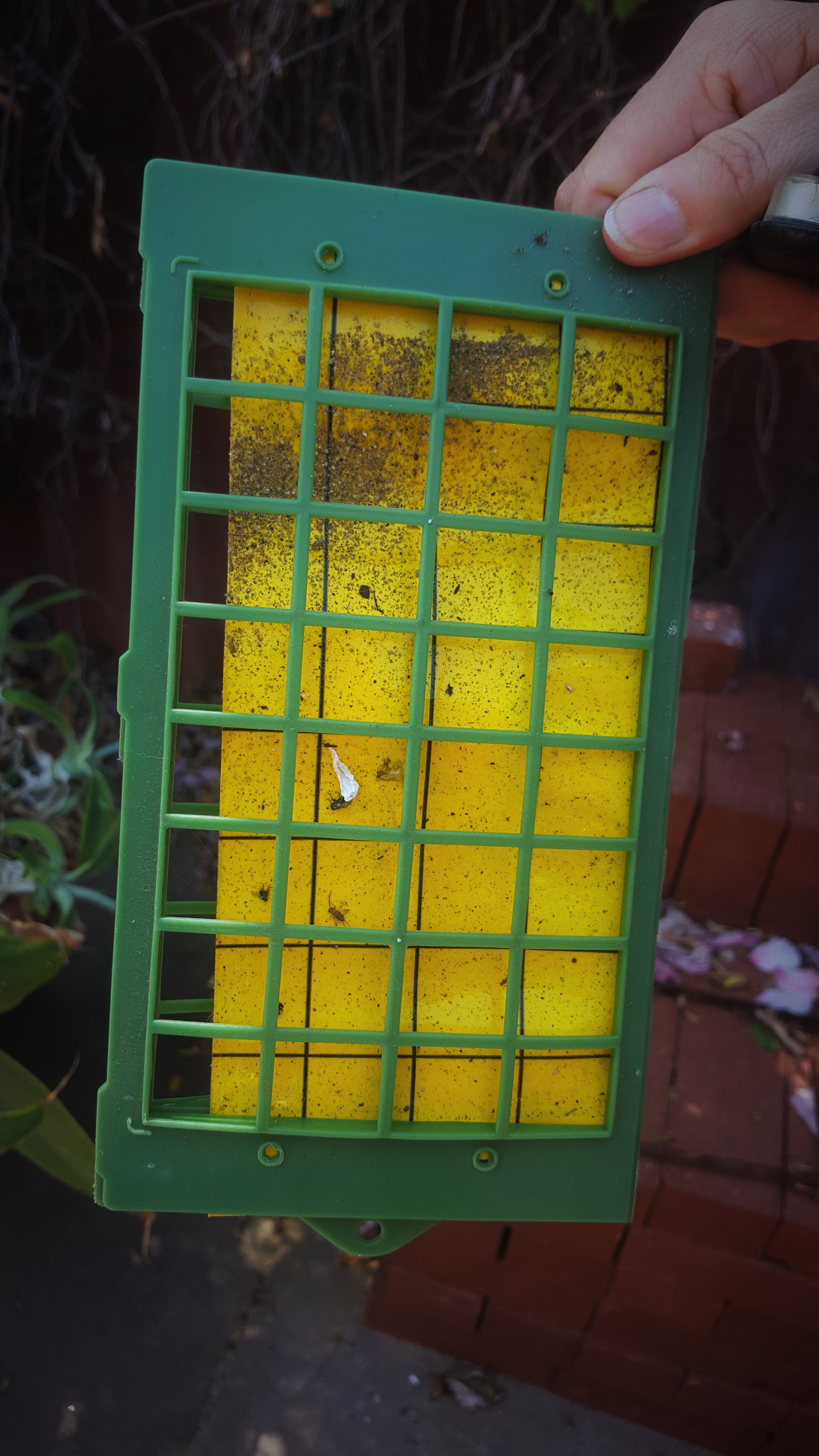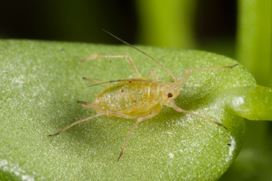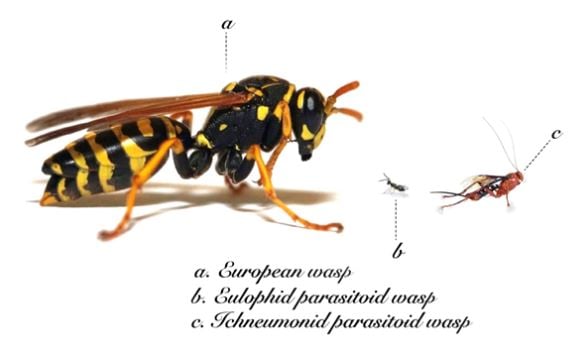
Sticky trap with cage in a citrus tree. Image credit: Kimberley Lamont
Sticky traps are pieces of coloured plastic or cardboard, typically yellow (or sometimes blue) in colour, coated with a thin layer of glue. Once you peel back a protective layer to expose the sticky surface you can then place them vertically in a paddock, veggie patch or on fruit trees with a twist tie or attached to a stake or fence post.

Sticky trap with insects. Image credit: Elia Pirtle (cesar)
The main purpose of these traps, which you can find at most plant nurseries, is to monitor for flying adult insects. As they are non-selective, a range of insects such as aphids, trips, fruit fly, leafminers, and whitefly are caught. In Victoria, sticky traps may only be sold or used if they are not capable of trapping an animal (birds, micro bats, rodents etc). All sticky traps sold must have a cage, barrier, cover or other design features which will prevent an animal from coming into contact with the adhesive surface.
As the adage goes, forewarned is forearmed. Here is what these traps can help you to prepare for:

Flat sticky trap with cage. Image credit: Madeleine Quirk, AUSVEG.
1. The presence of pests
Some common insect pests are tricky to monitor. They may be very small, especially when immature, or they may evade detection, inhabiting nooks on stems and leaves. Some species are green and are difficult to see against plant foliage.
Coloured sticky traps can help to detect the presence of such insects that otherwise might go undetected until they are an issue.
2. Seasonal pest changes
Many insect pests that attack veggies and fruits are winged as adults. This means that no matter how diligent you are in looking after your garden, there is always a threat of invasion from one insect or a population of insects.
An insect doesn’t even have to be a strong flyer to arrive over your fence. Aphids, for example, are very poor flyers but can still travel long distances with the help of the wind.

Green peach aphid. Image credit: Dr Andrew Weeks, cesar
The good news is that insect pests are usually seasonal, and coloured sticky traps can help you to assess when flying insect pest numbers are increasing or decreasing. By monitoring your sticky traps and improving your knowledge when to expect seasonal visitors you can decide on what management tactics to use before pest feeding damage becomes too high. For example, the sticky trap in the citrus tree in the main image is used to specifically monitor the emergence of citrus gall wasp in spring.
3. The arrival of good bugs
As coloured sticky traps are non-selective, unfortunately some flying beneficial insects can also be caught in the adhesive. The term beneficial insects refers to predatory species (also known as natural enemies), which attack and eat plant pests, and include parasitoid wasps*, hoverflies and ladybird beetles.
There is an important silver lining. As well as knowing which pests are present, you will also know when these good insects are around too. This is especially true of tiny parasitoid wasps which parasitise aphids, caterpillars and moth eggs. The aid that these wasps will provide in suppressing garden pest numbers is often not well understood or appreciated. Here at cesar we like to refer to them as ‘little farm helpers’ or ‘tiny biosecurity officers’. Importantly, these parasitoid wasps, and other beneficial species, are sensitive to pest control chemicals. If your sticky trap indicates that beneficials are in your patch, think twice about using insecticides.

European wasp and parasitoid wasp. Image credit: P Vertichel under Creative Commons licensing
*An important note – These parasitoid wasps can range in size but they are often very, very small and will not cause you harm. You can get an idea of the expected size from our comparison to a European wasp.
Read further information about using sticky traps on the Agriculture Victoria website.

3 comments, add yours.
Fast Food Near Me
Thanks for sharing such a blog!
King regards,
Boswell Zacho
Heather Giesen
“Flat sticky trap with cage”
Would you know where to purchase the cages for sticky traps?
This is a wonderful article : Forewarned is forearmed – the benefits of using sticky traps in your garden
jochongwah
AuthorHi Heather,
You can purchase them online or at many local nurseries or hardware stores.